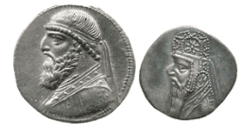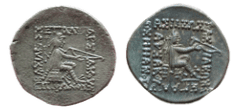The Parthian Coin Project is an international collaborative research project which goes beyond institutional and geographical boundaries. It brings together a number of coin specialists from museums with large holdings of ancient Iranian coins dating from c. 240 BC to AD 224. Coin specialists in the British Museum are therefore working together with colleagues in Vienna, Tehran, Paris, Berlin and New York. Altogether 66,564 Parthian coins are being studied by the group of participating institutions. The results will be published in nine volumes by the Austrian Academy and edited by the project’s joint directors, M. Alram and V.S. Curtis. The project’s aim is to present a new methodology for the study of Parthian coinage and to show how this important primary source contributes to a better understanding of the art, culture and religion of this period.


Why are coins important?
Coins represent an important primary source that provide information about the economy, history, art, culture and religion of the period in question.
The coins of Mithradates II specifically are especially crucial because our knowledge of the historical events of his reign (c.121-90 BC) is poor. This is unfortunate, given his importance as the king who consolidated the Parthian Empire after Mithradates I (c.171-138 BC) and expanded his realm. It was under his rule that Parthia became an equal opponent to Rome. Despite his key role in the history of Parthia, there remains great uncertainty about even the most basic issues, such as when he came to power and when and how he lost power or died. His coins, however, survive in great numbers and can shed light on what is otherwise a poorly documented reign.
The challenges of the coins of Mithradates II
The coins of Mithradates II are at first glance very homogeneous. Moreover, the coins are undated (with the exception of a single group of bronzes). Reconstructing their sequence and establishing where minted requires very close study of tiny differences. For instance, the coins can by placed in a temporal sequence by identifying small changes in the depiction of the archer on the back: these changes include whether he hold his bow in one or two hands and whether he has an arrow in addition to the bow.


There are also difficulties in mint attribution – the mints not explicitly named on the coins. We must work them out by relying on the control marks. However, their precise meaning is not always clear and they relate in some manner to the internal workings of mint. By combining mint marks with styles, we can allocate drachms to three main mints – Ecbatana, Rhagae and Arsacia (all in the Iranian highlands). Tetradrachms are almost exclusively minted in Seleucia on the Tigris (in modern Iraq). Mint marks were abandoned later in his reign but because we are able to distinguish the styles associated with each minting centre, we can infer where other coins without mint marks are minted.
Parthian coins do not usually include ruler’s name, only his dynastic name of Arsaces. We have had to decide what coins actually belong to Mithradates II and have been able to reattribute coins at the beginning and end of his reign to other rulers.
SNP 2 is more than just a catalogue
By delving deeply into the differences between coins that are similar at first glance, we are able to reconstruct the pattern of coinage throughout Mithradates II’s long reign of thirty years and track changes over time. In essence, we look to identify the framework beneath the artefacts.
The coins are the best historical source for him we have. For example, we can try to explain why he stops minting tetradrachms at Seleucia and focuses on drachm production in the Iranian highlands. We can identify firm central control over the types used and the legends. We can also interpret the iconography of the coins within their cultural context.
The task of working on the next volume, Vol. 4: Mithradates III ̶̶ Pacorus I (c. 57-38 BC) will be considerably easier, even if the challenges posed by those coins are slightly different. We have now a much better idea of what we need technically from the dedicated database and how it should be set up so that we can extract the most useful data from it.
Elizabeth J Pendleton, BIPS Fellow, British Museum

Dr Alram and Dr Curtis are the Joint Directors of the International Parthian Coin Project, Sylloge Nummorum Parthicorum.